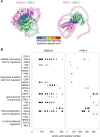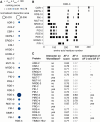Selecting genes for analysis using historically contingent progress: from RNA changes to protein-protein interactions
- PMID: 39788543
- PMCID: PMC11717427
- DOI: 10.1093/nar/gkae1246
Selecting genes for analysis using historically contingent progress: from RNA changes to protein-protein interactions
Abstract
Progress in biology has generated numerous lists of genes that share some property. But advancing from these lists of genes to understanding their roles is slow and unsystematic. Here we use RNA silencing in Caenorhabditis elegans to illustrate an approach for prioritizing genes for detailed study given limited resources. The partially subjective relationships between genes forged by both deduced functional relatedness and biased progress in the field were captured as mutual information and used to cluster genes that were frequently identified yet remain understudied. Some proteins encoded by these understudied genes are predicted to physically interact with known regulators of RNA silencing, suggesting feedback regulation. Predicted interactions with proteins that act in other processes and the clustering of studied genes among the most frequently perturbed suggest regulatory links connecting RNA silencing to other processes like the cell cycle and asymmetric cell division. Thus, among the gene products altered when a process is perturbed could be regulators of that process acting to restore homeostasis, which provides a way to use RNA sequencing to identify candidate protein-protein interactions. Together, the analysis of perturbed transcripts and potential interactions of the proteins they encode could help prioritize candidate regulators of any process.
© The Author(s) 2025. Published by Oxford University Press on behalf of Nucleic Acids Research.
Figures









Update of
-
Selecting genes for analysis using historically contingent progress: from RNA changes to protein-protein interactions.bioRxiv [Preprint]. 2024 Oct 19:2024.05.01.592119. doi: 10.1101/2024.05.01.592119. bioRxiv. 2024. Update in: Nucleic Acids Res. 2025 Jan 7;53(1):gkae1246. doi: 10.1093/nar/gkae1246. PMID: 38746289 Free PMC article. Updated. Preprint.
Similar articles
-
Selecting genes for analysis using historically contingent progress: from RNA changes to protein-protein interactions.bioRxiv [Preprint]. 2024 Oct 19:2024.05.01.592119. doi: 10.1101/2024.05.01.592119. bioRxiv. 2024. Update in: Nucleic Acids Res. 2025 Jan 7;53(1):gkae1246. doi: 10.1093/nar/gkae1246. PMID: 38746289 Free PMC article. Updated. Preprint.
-
Target-specific requirements for RNA interference can arise through restricted RNA amplification despite the lack of specialized pathways.Elife. 2024 Aug 20;13:RP97487. doi: 10.7554/eLife.97487. Elife. 2024. PMID: 39161220 Free PMC article.
-
Functional genomic analysis of RNA interference in C. elegans.Science. 2005 May 20;308(5725):1164-7. doi: 10.1126/science.1109267. Epub 2005 Mar 24. Science. 2005. PMID: 15790806
-
Studying gene function in Caenorhabditis elegans using RNA-mediated interference.Brief Funct Genomic Proteomic. 2008 May;7(3):184-94. doi: 10.1093/bfgp/eln019. Epub 2008 Apr 28. Brief Funct Genomic Proteomic. 2008. PMID: 18443013 Review.
-
Networks in Caenorhabditis elegans.Curr Opin Genet Dev. 2011 Dec;21(6):787-98. doi: 10.1016/j.gde.2011.10.003. Epub 2011 Nov 4. Curr Opin Genet Dev. 2011. PMID: 22054717 Review.
References
MeSH terms
Substances
Grants and funding
LinkOut - more resources
Full Text Sources

